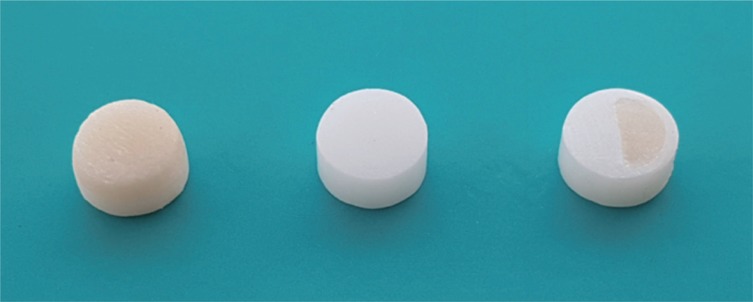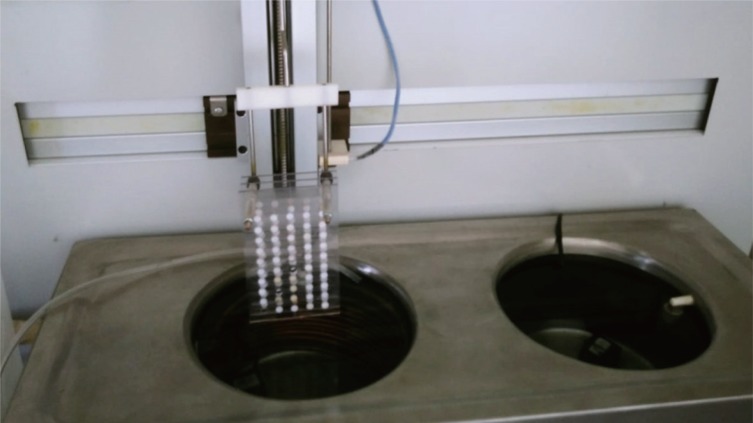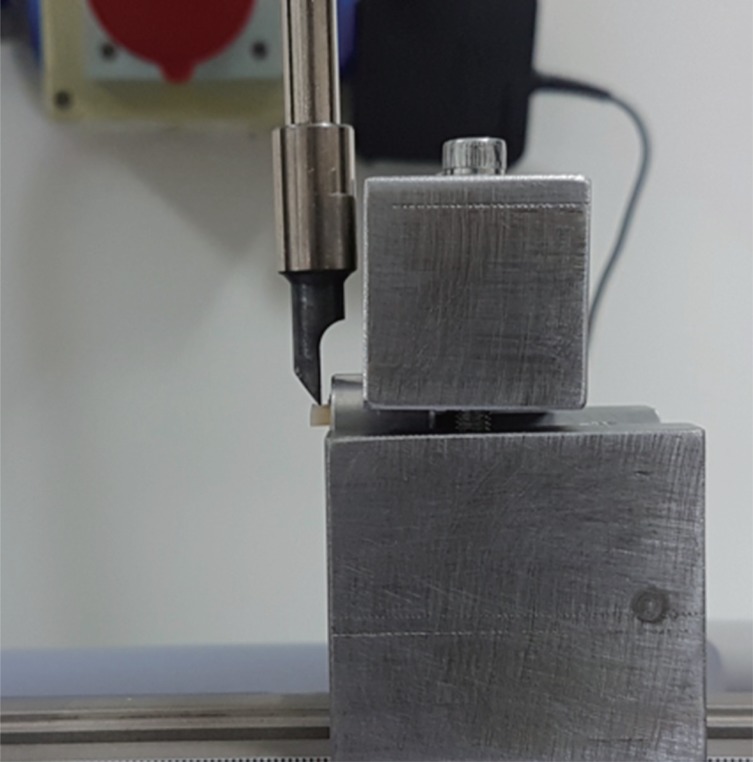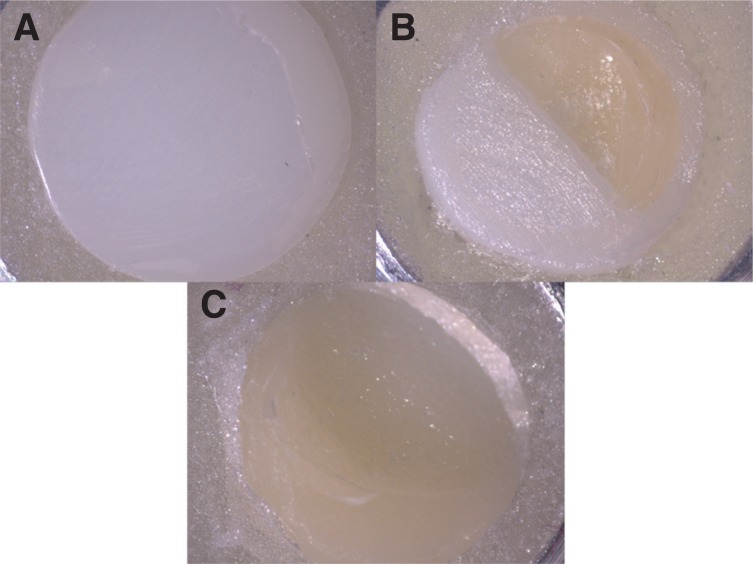J Adv Prosthodont.
2019 Oct;11(5):297-304. 10.4047/jap.2019.11.5.297.
Repair bond strength of composite resin to zirconia restorations after different thermal cycles
- Affiliations
-
- 1Department of Prosthodontics, Faculty of Dentistry, Akdeniz University, Antalya, Turkey. omerkrml@ymail.com
- KMID: 2462113
- DOI: http://doi.org/10.4047/jap.2019.11.5.297
Abstract
- PURPOSE
This in vitro study investigated the repair bond strength of the zirconia ceramic after different aging conditions.
MATERIALS AND METHODS
In order to imitate the failure modes of veneered zirconia restorations, veneer ceramic, zirconia, and veneer ceramic-zirconia specimens were prepared and were divided into 4 subgroups as: control (37℃ distilled water for 24 hours ) and 3000, 6000, 12000 thermal cycling groups (n=15). Then, specimens were bonded to composite resin using a porcelain repair kit according to the manufacturer recommendation. The repair bond strength (RBS) test was performed using a universal testing machine (0.5 mm/min). Failure types were analyzed under a stereomicroscope. Two-way ANOVA and Bonferroni test were used for statistical analysis.
RESULTS
The RBS values of zirconia specimens were statistically significant and higher than veneer ceramic and veneer ceramic-zirconia specimens in control, 3000 and 6000 thermal cycling groups (P<.05). When 12000 thermal cycles were applied, the highest value was found in zirconia specimens but there was no statistically significant difference between veneer ceramic and veneer ceramic-zirconia specimens (P>.05). Veneer ceramic specimens exhibited cohesive failure types, zirconia specimens exhibited adhesive failure types, and veneer ceramic-zirconia specimens exhibited predominately mixed failure types.
CONCLUSION
Thermal cycling can adversely affect RBS of composite resin bınded to level of fractured zirconia ceramics.
Keyword
MeSH Terms
Figure
Reference
-
1. Guazzato M, Albakry M, Ringer SP, Swain MV. Strength, fracture toughness and microstructure of a selection of all-ceramic materials. Part I. Pressable and alumina glass-infiltrated ceramics. Dent Mater. 2004; 20:441–448. PMID: 15081550.
Article2. Tsalouchou E, Cattell MJ, Knowles JC, Pittayachawan P, McDonald A. Fatigue and fracture properties of yttria partially stabilized zirconia crown systems. Dent Mater. 2008; 24:308–318. PMID: 17681371.
Article3. Anusavice K, Shen C, Rawls HR. Phillips' science of dental materials. Elsevier Health Sciences. 12th ed. Missouri: Saunders Elsevier Inc.;2013.4. Al-Dohan HM, Yaman P, Dennison JB, Razzoog ME, Lang BR. Shear strength of core-veneer interface in bi-layered ceramics. J Prosthet Dent. 2004; 91:349–355. PMID: 15116036.
Article5. Kelly JR, Tesk JA, Sorensen JA. Failure of all-ceramic fixed partial dentures in vitro and in vivo: analysis and modeling. J Dent Res. 1995; 74:1253–1258. PMID: 7629333.
Article6. Chung KH, Hwang YC. Bonding strengths of porcelain repair systems with various surface treatments. J Prosthet Dent. 1997; 78:267–274. PMID: 9297643.
Article7. Appeldoorn RE, Wilwerding TM, Barkmeier WW. Bond strength of composite resin to porcelain with newer generation porcelain repair systems. J Prosthet Dent. 1993; 70:6–11. PMID: 8366459.
Article8. Haselton DR, Diaz-Arnold AM, Dunne JT Jr. Shear bond strengths of 2 intraoral porcelain repair systems to porcelain or metal substrates. J Prosthet Dent. 2001; 86:526–531. PMID: 11725281.
Article9. Ozcan M. The use of chairside silica coating for different dental applications: a clinical report. J Prosthet Dent. 2002; 87:469–472. PMID: 12070506.10. Gregory WA, Moss SM. Effects of heterogeneous layers of composite and time on composite repair of porcelain. Oper Dent. 1990; 15:18–22. PMID: 2195473.11. Shahverdi S, Canay S, Suahin E, Bilge A. Effects of different surface treatment methods on the bond strength of composite resin to veneer ceramic. J Oral Rehabil. 1998; 25:699–705. PMID: 9758401.12. Thurmond JW, Barkmeier WW, Wilwerding TM. Effect of porcelain surface treatments on bond strengths of composite resin bonded to porcelain. J Prosthet Dent. 1994; 72:355–359. PMID: 7990039.
Article13. Kern M, Barloi A, Yang B. Surface conditioning influences zirconia ceramic bonding. J Dent Res. 2009; 88:817–822. PMID: 19767578.
Article14. Özcan M, Vallittu PK. Effect of surface conditioning methods on the bond strength of luting cement to ceramics. Dent Mater. 2003; 19:725–731. PMID: 14511730.
Article15. Özcan M, Valandro LF, Amaral R, Leite F, Bottino MA. Bond strength durability of a resin composite on a reinforced ceramic using various repair systems. Dent Mater. 2009; 25:1477–1483. PMID: 19671476.16. Kirmali O, Kapdan A, Kustarci A, Er K. Veneer ceramic to Y-TZP bonding: comparison of different surface treatments. J Prosthodont. 2016; 25:324–329. PMID: 25996406.
Article17. Blum IR, Nikolinakos N, Lynch CD, Wilson NH, Millar BJ, Jagger DC. An in vitro comparison of four intra-oral ceramic repair systems. J Dent. 2012; 40:906–912. PMID: 22819811.
Article18. D'Amario M, Campidoglio M, Morresi AL, Luciani L, Marchetti E, Baldi M. Effect of thermocycling on the bond strength between dual-cured resin cements and zirconium-oxide ceramics. J Oral Sci. 2010; 52:425–430. PMID: 20881336.19. Lüthy H, Loeffel O, Hammerle CH. Effect of thermocycling on bond strength of luting cements to zirconia ceramic. Dent Mater. 2006; 22:195–200. PMID: 16143382.20. Donovan TE. Metal-free dentistry. J Esthet Restor Dent. 2005; 17:141–143. PMID: 15996382.
Article21. Fradeani M, D'Amelio M, Redemagni M, Corrado M. Five-year follow-up with Procera all-ceramic crowns. Quintessence Int. 2005; 36:105–113. PMID: 15732546.22. Guess PC, Kulis A, Witkowski S, Wolkewitz M, Zhang Y, Strub JR. Shear bond strengths between different zirconia cores and veneering ceramics and their susceptibility to thermocycling. Dent Mater. 2008; 24:1556–1567. PMID: 18466964.
Article23. Freilich MA, Karmaker AC, Burstone CJ, Goldberg AJ. Development and clinical applications of a light-polymerized fiber-reinforced composite. J Prosthet Dent. 1998; 80:311–318. PMID: 9760363.
Article24. Llobell A, Nicholls J, Kois J, Daly C. Fatigue life of veneer ceramic repair systems. Int J Prosthodont. 1992; 5:205–213. PMID: 1524642.25. Ozcan M. Evaluation of alternative intra-oral repair techniques for fractured ceramic-fused-to-metal restorations. J Oral Rehabil. 2003; 30:194–203. PMID: 12535148.26. Kamposiora P, Papavasiliou G, Bayne SC, Felton DA. Stress concentration in all-ceramic posterior fixed partial dentures. Quintessence Int. 1996; 27:701–706. PMID: 9180408.27. Hooshmand T, van Noort R, Keshvad A. Bond durability of the resin-bonded and silane treated ceramic surface. Dent Mater. 2002; 18:179–188. PMID: 11755598.
Article28. Pameijer CH, Louw NP, Fischer D. Repairing fractured porcelain: how surface preparation affects shear force resistance. J Am Dent Assoc. 1996; 127:203–209. PMID: 8682989.
Article29. Cavalcanti AN, Pilecki P, Foxton RM, Watson TF, Oliveira MT, Gianinni M, Marchi GM. Evaluation of the surface roughness and morphologic features of Y-TZP ceramics after different surface treatments. Photomed Laser Surg. 2009; 27:473–479. PMID: 19405819.
Article30. Ozcan M, Niedermeier W. Clinical study on the reasons for and location of failures of metal-ceramic restorations and survival of repairs. Int J Prosthodont. 2002; 15:299–302. PMID: 12066495.31. Shiu P, De Souza-Zaroni WC, Eduardo Cde P, Youssef MN. Effect of feldspathic ceramic surface treatments on bond strength to resin cement. Photomed Laser Surg. 2007; 25:291–296. PMID: 17803387.
Article32. Akyil MS, Yilmaz A, Karaalioğlu OF, Duymuş ZY. Shear bond strength of repair composite resin to an acid-etched and a laser-irradiated feldspathic ceramic surface. Photomed Laser Surg. 2010; 28:539–545. PMID: 19852588.33. Attia A, Kern M. Fracture strength of all-ceramic crowns luted using two bonding methods. J Prosthet Dent. 2004; 91:247–252. PMID: 15060494.
Article34. Leibrock A, Degenhart M, Behr M, Rosentritt M, Handel G. In vitro study of the effect of thermo- and load-cycling on the bond strength of porcelain repair systems. J Oral Rehabil. 1999; 26:130–137. PMID: 10080310.
Article35. Kirmali O, Kapdan A, Harorli OT, Barutcugil C, Ozarslan MM. Efficacy of ceramic repair material on the bond strength of composite resin to zirconia ceramic. Acta Odontol Scand. 2015; 73:28–32. PMID: 25373516.
Article36. Şen D, NayıZr EH. Yüzey Hazırlığının Porselen Tamir Materyallerinin Bağlantı Kuvveti Üzerine Etkisi. J Istanb Univ Fac Dent. 1997; 31:69–75.37. Matinlinna JP, Vallittu PK. Bonding of resin composites to etchable ceramic surfaces - an insight review of the chemical aspects on surface conditioning. J Oral Rehabil. 2007; 34:622–630. PMID: 17650173.
Article38. Corazza PH, Cavalcanti SC, Queiroz JR, Bottino MA, Valandro LF. Effect of post-silanization heat treatments of silanized feldspathic ceramic on adhesion to resin cement. J Adhes Dent. 2013; 15:473–479. PMID: 23593645.39. Thompson JY, Stoner BR, Piascik JR, Smith R. Adhesion/cementation to zirconia and other non-silicate ceramics: where are we now? Dent Mater. 2011; 27:71–82. PMID: 21094526.
Article40. Tzanakakis EG, Tzoutzas IG, Koidis PT. Is there a potential for durable adhesion to zirconia restorations? A systematic review. J Prosthet Dent. 2016; 115:9–19. PMID: 26548872.
Article41. Seabra B, Arantes-Oliveira S, Portugal J. Influence of multimode universal adhesives and zirconia primer application techniques on zirconia repair. J Prosthet Dent. 2014; 112:182–187. PMID: 24445031.
Article42. Wolfart M, Lehmann F, Wolfart S, Kern M. Durability of the resin bond strength to zirconia ceramic after using different surface conditioning methods. Dent Mater. 2007; 23:45–50. PMID: 16427692.
Article43. Demetoglu GA, Zortuk M. Effect of surface treatments on leakage of zirconium oxide ceramics. Meandros Med Dent J. 2016; 17:64.44. Bailey LF, Bennett RJ. DICOR surface treatments for enhanced bonding. J Dent Res. 1988; 67:925–931. PMID: 3049721.
Article45. Chang JC, Powers JM, Hart D. Bond strength of composite to alloy treated with bonding systems. J Prosthodont. 1993; 2:110–114. PMID: 8242163.
Article46. Passia N, Mitsias M, Lehmann F, Kern M. Bond strength of a new generation of universal bonding systems to zirconia ceramic. J Mech Behav Biomed Mater. 2016; 62:268–274. PMID: 27232829.
Article47. Kamada K, Yoshida K, Atsuta M. Effect of ceramic surface treatments on the bond of four resin luting agents to a ceramic material. J Prosthet Dent. 1998; 79:508–513. PMID: 9597602.
Article48. Matsumura H, Kato H, Atsuta M. Shear bond strength to feldspathic porcelain of two luting cements in combination with three surface treatments. J Prosthet Dent. 1997; 78:511–517. PMID: 9399196.
Article49. Blatz MB, Sadan A, Arch GH Jr, Lang BR. In vitro evaluation of long-term bonding of Procera AllCeram alumina restorations with a modified resin luting agent. J Prosthet Dent. 2003; 89:381–387. PMID: 12690351.
Article50. Kirmali O, Akin H, Ozdemir AK. Shear bond strength of veneering ceramic to zirconia core after different surface treatments. Photomed Laser Surg. 2013; 31:261–268. PMID: 23741995.
Article51. Polat S, Cebe F, Tunçdemir A, Öztürk C, Üşümez A. Evaluation of the bond strength between aged composite cores and luting agent. J Adv Prosthodont. 2015; 7:108–114. PMID: 25932308.
Article52. Uludamar A, Akalin B, Kulak Y. Surface preparations of zirconia based full ceramic restorations before cementation. Cumhuriyet Dent J. 2011; 14:140–153.53. Akyil MS, Uzun IH, Bayindir F. Bond strength of resin cement to yttrium-stabilized tetragonal zirconia ceramic treated with air abrasion, silica coating, and laser irradiation. Photomed Laser Surg. 2010; 28:801–808. PMID: 20969444.54. Külünk T, Saraç Ş. Tam seramik sistemlerde farklı ağız içi tamir setlerinin kullanımımın tamir dayanımıma etkisi. J Ondokuz Mayıs Univ Fac Dent. 2010; 10:87–95.55. Özdemir E, Niğiz R, Zortuk M. Farklı yüzey hazırlıklarının porselen kompozit rezin bağlantısı üzerine etkisinin in-vitro araştırılması. J Gazi Univ Fac Dent. 2007; 24:75–82.56. Chadwick RG, Mason AG, Sharp W. Attempted evaluation of three porcelain repair systems-what are we really testing? J Oral Rehabil. 1998; 25:610–615. PMID: 9781864.
- Full Text Links
- Actions
-
Cited
- CITED
-
- Close
- Share
- Similar articles
-
- A study on the shear bond strength between 3D printed resin and provisional resin after thermal cycling
- Evaluation of shear bond strengths of gingiva-colored composite resin to porcelain, metal and zirconia substrates
- The shear bond strength of two adhesives bonded to composite resin and glass ionomer cement restorations
- Evaluation of the bond strength between aged composite cores and luting agent
- Effect of various intraoral repair systems on the shear bond strength of composite resin to zirconia





